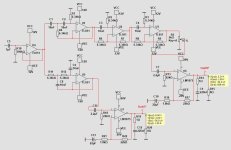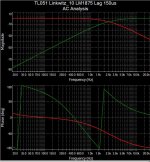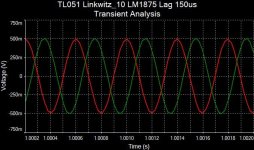Yes and pay attention to the polarity of the drivers. I would set C4 to a bigger value 15nF but you should measure the delay and adjust.I added a delay allpass to the highpass.
This is the circuit I used: Would this work correctly?
View attachment 1414873
In my designs I usually use two all pass in series to keep the polarity, it is a detail 😉
If you see delay as simply phase in the context of a band of frequencies, should it matter how much actual delay you use? In a sense, an all-pass filter as a tool is just an opportunity to alter phase free of added response variations. Your goal at the end of the day is only to have the needed relative phase and response relationship between the two ways at each frequency around the cross.I guess the proof would be some kind of test against a known control. The difficulty vs dsp I suppose is how does the user calculate/fiddle/set the delay depending on the drivers and baffle layout/cabinet used, per design,
Alternately, sometimes you have some wiggle room with regard to the relative response relationship over parts of the crossover region, and can afford to manipulate a response slope to create the effect of delay. You can then use global EQ to fix it without harming the relationship, especially given that many are already planning to EQ globally regardless.
Your goal at the end of the day is only to have the needed relative phase and response relationship between the two ways at each frequency around the cross.
thats being lazy, you should strive so that relative phase is extends well above and below the crossover frequency.
I'm sure we mean the same thing. For me the crossover range is an infinite number of frequencies in the band where both sources are working, all the way until one becomes insignificant.thats being lazy, you should strive so that relative phase is extends well above and below the crossover frequency.
Sorry for the confusion 😉
For proper 2nd order delay allpass, see https://www.diyaudio.com/community/...-filter-design-questions.306219/#post-5044396, posts #9 and #14
Selecting the crossover frequency depends on individual drivers, especially the beaming of midbass. Midbass will start narrowing above certain frequency and may show some breakups. You naturally want to supress breakups by selecting lower crossover. This however presents challenge to tweeter. Smooth of axis is the key. Here is more about beaming and of axis response.When the four resistors are 6k34
the crossover frequency is 2510 Hz. See image.
By changing any frequency can be achieved.
View attachment 1414293
http://www.troelsgravesen.dk/Beaming.htm
Selecting too high crossover frequency for 8" midbass and 1" tweeter can lead to mismatched directivity, as shown by polar plots. Midbass beaming and tweeter blooming leads to uneven of axis response. Waveguiding tweeter may help to narrowing its response.
https://audiosciencereview.com/foru...ers-8-inch-woofer-directivity-question.28929/
https://audiosciencereview.com/foru...ers-8-inch-woofer-directivity-question.28929/
Lineup, I hope you do not mind me inserting some links about selecting the crossover frequency. This is critical in 2 way speaker design.
No, I will not be building.are you actually going to build this active crossover and speaker system?
I just publish because it is nice to do some simulation.
I leave the building to those that are interested.
Thanks @adasonLineup, I hope you do not mind me inserting some links about selecting the crossover frequency. This is critical in 2 way speaker design.
You just post whatever you like.
There is always some things to learn.
I have as an example looked at 2 ScanSpeak elements. 1" and 180mm ~7"
https://www.scan-speak.dk/datasheet/pdf/d2908-716000.pdf
https://www.scan-speak.dk/datasheet/pdf/18we-8542t00.pdf
I used 2 all pass filters in series, it produced better results. For me. I had to delay about 22uS which doesn't seem like much but it change things.
I did it the cheap way; I adjusted the delay until the best null showed on the measurement between the T and M.
I did it the cheap way; I adjusted the delay until the best null showed on the measurement between the T and M.
- Home
- Loudspeakers
- Multi-Way
- Active Crossover Linkwitz-Riley 12dB for BiAmping


